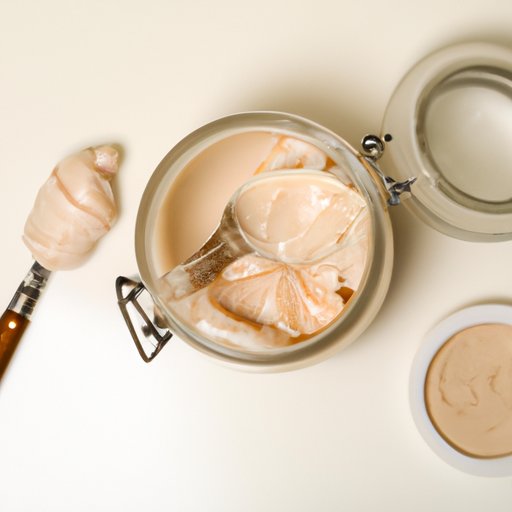
I. Introduction
Yeast infections are a common ailment experienced by many women. They occur when there is an overgrowth of the fungus candida in the vagina, resulting in uncomfortable symptoms such as itching, burning, and discharge. In this article, we will explore various ways to get rid of a yeast infection at home. Whether you prefer natural remedies or over-the-counter remedies, we have got you covered.
II. Identifying a Yeast Infection
The first step in treating a yeast infection is identifying it. Common symptoms include itching, burning, redness, swelling, and white discharge. However, some women may have no symptoms at all. It is important to seek a professional diagnosis before starting any treatment. Your healthcare provider will determine whether you have a yeast infection or another type of infection and will provide a prescription or treatment plan accordingly.
III. Over-the-Counter Remedies
If you have a yeast infection, your healthcare provider may recommend an over-the-counter antifungal cream, suppository, or oral medication. These are available at most drugstores and pharmacies. Some common products include Monistat, Gyne-Lotrimin, and Diflucan. Be sure to read the instructions carefully and follow the recommended dosage and duration of use.
IV. Preventative Measures
Preventing a yeast infection is key to avoiding discomfort. Here are some preventative measures you can take to reduce your risk:
Maintain Good Hygiene and Wear Breathable Clothing
To prevent yeast infections, it is important to keep the vaginal area clean and dry. This means avoiding tight-fitting clothing and wearing breathable fabrics like cotton. It is also important to change out of wet bathing suits or workout clothes as soon as possible to prevent moisture buildup.
Avoid Douching and Using Non-pH Balanced Products
Douching and using non-pH balanced products like scented soaps can disrupt the natural balance of bacteria in the vagina, leading to an overgrowth of yeast. Stick to gentle and pH-balanced feminine products to keep things in balance.
Use pH-Balanced Feminine Products
Using pH-balanced feminine products can help maintain the natural balance of bacteria in the vagina. Some great options include The Honey Pot Company and Love Wellness.
V. Natural Remedies
If you prefer to go the natural route in treating your yeast infection, there are several remedies you can try:
Yogurt
Yogurt is a natural source of probiotics, which help balance the bacteria in the vagina. Applying plain, unsweetened yogurt to the affected area can help soothe the discomfort associated with yeast infections.
Garlic
Garlic has antifungal and antibacterial properties that can help fight off yeast infections. Inserting a clove of garlic into the vagina can help alleviate symptoms.
Tea Tree Oil
Tea tree oil has antifungal properties and can help kill off yeast. Dilute a few drops in a carrier oil before applying to the affected area.
VI. Diet and Yeast Infections
Diet plays a crucial role in preventing yeast infections. Here are some tips:
Avoid Sugar, Refined Carbs, and Alcohol
Consuming too much sugar, refined carbs, and alcohol can increase the likelihood of developing a yeast infection. Limit your intake of these foods to prevent yeast overgrowth.
Eat a Diet Rich in Probiotics, Fiber, and Whole Foods
Eating a diet rich in probiotics, fiber, and whole foods can help prevent yeast infections by promoting a healthy balance of bacteria in the gut and vagina. Incorporate foods like kefir, sauerkraut, and whole grains into your diet.
VII. Choosing the Right Underwear
The type of underwear you wear can also affect your risk of developing a yeast infection. Here are some tips:
Avoid Tight-Fitting Clothes and Synthetic Materials
Wearing tight-fitting clothes and synthetic materials can trap moisture and promote yeast overgrowth. Opt for loose-fitting clothes made from breathable materials like cotton instead.
Choose Cotton Over Synthetic Materials
Cotton is a breathable material that helps absorb moisture and prevent yeast overgrowth. Choose cotton underwear and avoid synthetic materials like nylon and polyester.
VIII. Sexual Activity and Yeast Infections
Sexual activity can also increase your likelihood of developing a yeast infection. Here are some tips for reducing your risk:
Use Lubricants and Practice Safe Sex
Using lubricants and practicing safe sex can reduce your risk of developing a yeast infection. Be sure to use condoms and avoid sexual activity with partners who have a yeast infection.
Urinate After Intercourse
Urinating after intercourse helps flush out any bacteria that may have entered the urethra during sex. This can help reduce the likelihood of developing a yeast infection.
IX. Conclusion
Yeast infections are a common ailment experienced by many women. While they can be uncomfortable, there are several remedies you can try to get rid of them at home. Whether you prefer natural remedies or over-the-counter medications, the key is to identify and address the underlying cause of the infection. By maintaining good hygiene, choosing the right underwear, eating a healthy diet, and practicing safe sex, you can reduce your risk of developing a yeast infection. If your symptoms persist or worsen, be sure to seek medical attention.




